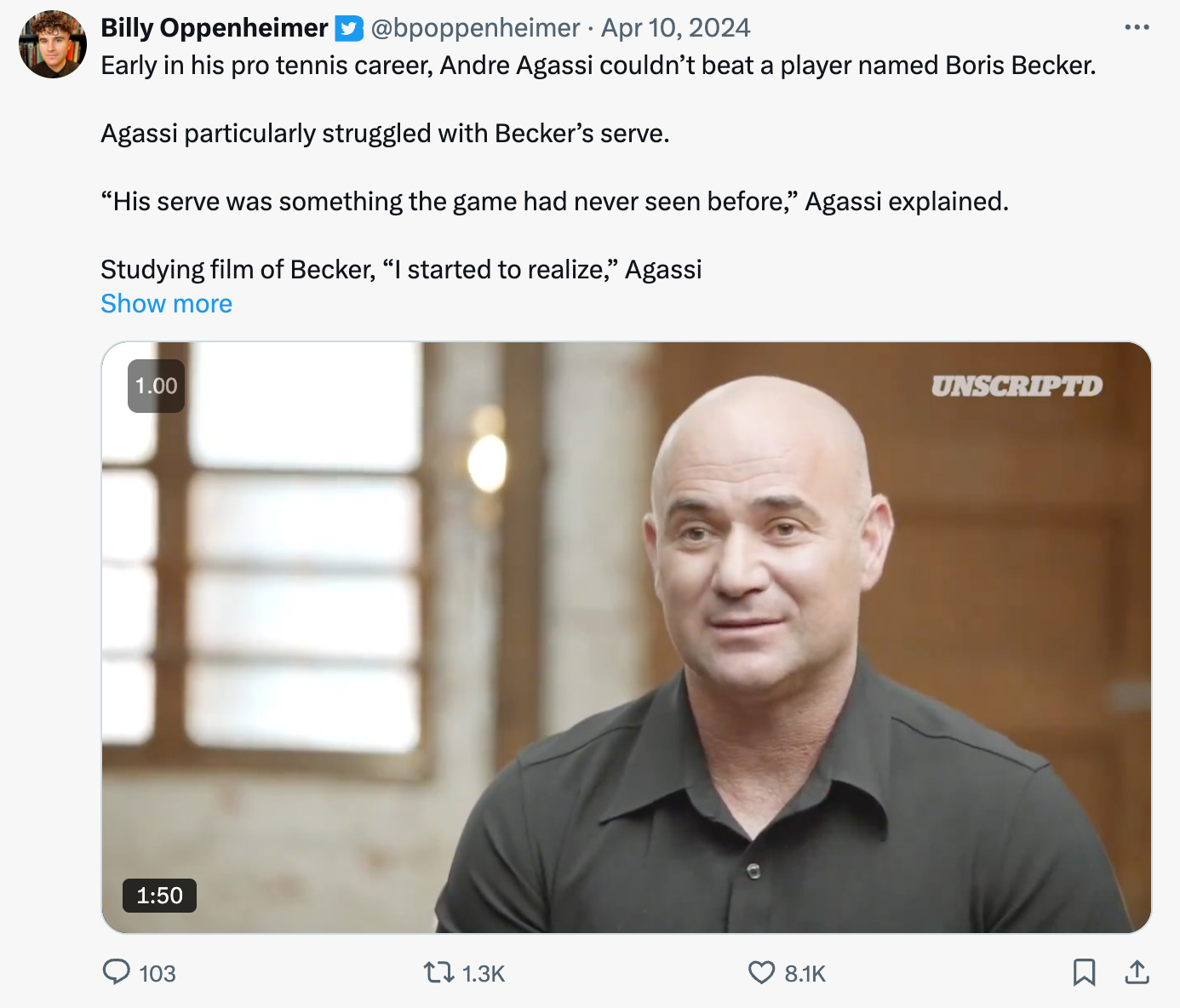Popup Masterclass Tomorrow: My #1 Hack For Aspiring Thought Leaders
TLDR
Over the last 5 years, I’ve personally helped 100+ thought leaders create blockbuster articles and…
Rise above the noise of the Internet and create content they’re proud of
Become the recognized expert in their niche
Build a 6-figure business with their ideas in one of six ways
Build a process that maximizes their joy and growth
The #1 challenge I see that stops 99.9% is the trough of disillusionment:
It’s a…
Period of a few months to a few years
When aspiring thought leaders are just getting started
Where they struggle to get enough attention and income
To justify their investment in thought leadership
While they build the skills, voice, niche, and following to get off the ground
The good news is that there is a shortcut that I’ve seen work over and over, which I’ve rarely seen talked about.
That shortcut is video clip curation.
To help people understand the opportunity and how to curate video clips, I’m conducting a popup masterclass tomorrow, March 20, at 11am-12:30pm EST.
The class is for paid subscribers only, and the link to join is at the bottom of this post. The class is 100% educational, and there is no pitch at the end.
Now, on to the larger overview of the opportunity…
Standing Out Online As A Thought Leader Is Hard
I spent the first half of my writing career in relative obscurity.
During one painful period, I wrote hundreds of blog posts to which I got less than 100 comments in total.
A few years later, I got my confidence back up and tried another 1-year writing challenge.
Same brutal result.
That was 500+ nights of staying up late with high hopes and ultimately falling on my face each time.
In short…
I loved writing.
I thought I had good ideas.
It just wasn’t clicking.
I didn’t know why.
Very frustrating.
Then, I made a critical decision.
In 2013, I decided to become deliberate. Rather than treating writing like a trial-and-error hobby, I did the following instead:
I spent thousands of hours studying online virality in spreadsheets— literally going article by article looking for patterns.
I did 4,000+ A/B tests of titles to test the patterns I saw.
I spent dozens of hours researching each and every article I wrote.
I went through 15 drafts before I published any of my articles.
I paid dozens of top thought leaders for their advice.
I built an entire thought leadership system.
In short. It worked.
Rather than a black box, I had a system that predictably and consistently worked.
Since then, my writing has been:
Viewed 100M+ times
Featured in publications like the Harvard Business Review, Fortune, Forbes, TIME, Inc, Entrepreneur, and the World Economic Forum
Generated millions in revenue
In addition, I’ve taught 5 year-long, small group thought leadership cohorts so I’ve seen the patterns of what works and what doesn’t across 100+ students.
I share all of that not to brag but to prove a point.
What I share in this post will seem incredibly simple. So simple that it’s easy to overlook.
By sharing the arc of my story, I hope you understand that what I share represents the simplicity on the other side of complexity. It is not one of many hacks. It’s the ultimate hack that I’ve come across for going from zero to one as a thought leader quickly and reliably.
With that said, let’s dive deeper and explore why writing online is so hard. As the saying goes, “A problem half-understood is a problem half solved.”
Until You Understand The Two Reasons Why Writing Online Is So Hard, You Will Fail
This chart tells you half the story of why rising above the noise of the Internet is so hard:
In short, the amount of attention we have available to devote to content is limited, while the amount of content is growing at a super-exponential rate. The core implication is that you need to drastically increase the quality of what you create in order to stand out or you will become invisible.
The second half of the story is that 99% of aspiring thought leaders use an approach that is simply doomed to fail from the start:
They share ideas that come to their mind (only pulling from their expertise).
Without understanding the fundamentals of how to distill those ideas.
While having little understanding of what resonates online and why.
Thus, without realizing it, most aspiring thought leaders are throwing spaghetti on the wall and hoping it sticks. Like I was in the beginning.
They’re going into a casino where the odds are against you 90%/10% and thinking they’ll get lucky.
On the other hand, top thought leaders who rise above the noise and put the odds in their favor do things differently:
They augment their expertise via deep research or incredibly unique life experiences.
They study the fundamentals of the craft
They study what causes ideas to spread online
They iteratively find their unique niche, their authentic voice, and a production process they love.
The problem with this proven approach is that it’s time-intensive.
The brutal reality is that it takes most people years to break through from scratch while learning part-time. Almost all of the overnight success stories you hear about have long backstories where they spent years developing an expertise, testing their ideas, and learning thought leader skills. And the few that didn’t are simply incredibly lucky and not good models to emulate.
Speaking frankly, from observing hundreds of aspiring thought leaders first-hand, most people just aren’t willing to go through the years of learning and obscurity even if they think they are committed in the beginning.
Fortunately, there is a shortcut that is surprisingly effective, overlooked, and easy…
13 Reasons Why Video Clip Curation Is The #1 Shortcut For Thought Leaders
The single largest leverage point is video clip curation—the process of finding, clipping, packaging, contextualizing, and publishing video clips as standalone posts or as parts of larger posts.
Sounds so simple that it’s easy to overlook. Right?
Well, here are the core reasons why video clip curation is amazing, whether you’re just getting started or you are a seasoned pro:
Ease. Finding and editing short video is way, way easier than you think. The tools to do it are getting better and better.
Algorithms. Social media algorithms universally love short-form videos. Short videos exploded on TikTok and now nearly every platform highlights them in their newsfeed.
Video Dominates. Short-form videos are engaging for readers to consume and stand out. The people who watch videos outnumber the people who read articles.
Content Legos. Short-form videos can be combined into longer videos. Thus, you can reuse video clips over and over in different ways.
Selling Your Sawdust. Short-form video turns your research process into content. Whereas typical notes don’t do well as posts, shortform videos do great.
Proven. Rather than trial-and-error, you can clip the very best content on the entire Internet that has been proven already. In other words, there are 1 billion people creating content every week. You can curate the very best of that content related to your niche and repackage it.
Overlooked. Very few people create video clips, so it’s easy to stand out in a text or photo heavy newsfeed. Very few niches have someone curating the best video content.
Thought Leadership. Sharing clips isn’t just about sharing other people’s ideas. You can use clips to capture attention and then share your own unique ideas.
Useful In Classes. Video clips are perfect ways to break up long classes or keynotes with clips that reinforce your points.
Fast Iteration. Publishing video clips makes it possible to publish often and get more feedback. More feedback makes it possible to iterate faster.
Consistency. Many people procrastinate on publishing consistently because they’re hesitant to put themselves out there, and they’re not sure if their ideas are good enough. Curating other people’s videos makes it easier to get started and to stay consistent.
High Perceived Value. Video clips can be packaged together into a course that people pay for.
Automation Ability. If you want, the entire process of finding, clipping, and distilling video clips will be completely automatable in the near future.
I go deeper into each of these benefits in How To Easily Curate Short Form Video Clips In Order To Rise Above The Noise Of The Internet. It’s critical to understand these benefits at a deeper level, because it’s very easy to overlook how effective video clip curation is.
And, even if you’re already an established thought leader like I am, I still curate short videos every single week.
But, you don’t have to take my word for it…
Case Studies Of People Who Made Their Thought Leader Careers As Video Curators
I was originally inspired to share clips via three people:
Billy Oppenheimer’s X account where he shares videos that often get 1,000+ likes.
Evan Carmichael’s YouTube account with nearly 4 million subscribers.
Nathan Baugh’s X account where he has shared hundreds of video clips.
I saw these individuals just doing video clip curation and reaching millions of people.
More recently, two of the top X accounts posting about AI are focused purely on video clip curation. I watch every video clip of the following two curators:
Since that inspiration, I’ve curated hundreds of video clips that have been seen 10M+ times on YouTube, LinkedIn, and in this newsletter.
I’ve shared these clips as stand-alone posts:
And as part of longer articles. For example, in So Passionate You Never Stop Improving: The Secret Behind the Success Of Asimov, Jobs, Seinfeld, Oprah, Buffett, Newton, And All The Greats, I shared 10+ video clips.
With that context, I invite you to join me in the video curation popup masterclass.
ZOOM LINK TO JOIN THE POPUP CLASS
During the class, I will walk you through the process of producing a video clip from start to finish:
Finding a video clip (using multiple methods)
Clipping it
Create a summary of it
Then, I’ll open up for questions.
After the session, you'll have everything you need to begin creating your own clips immediately."
You can join the session with this info:








